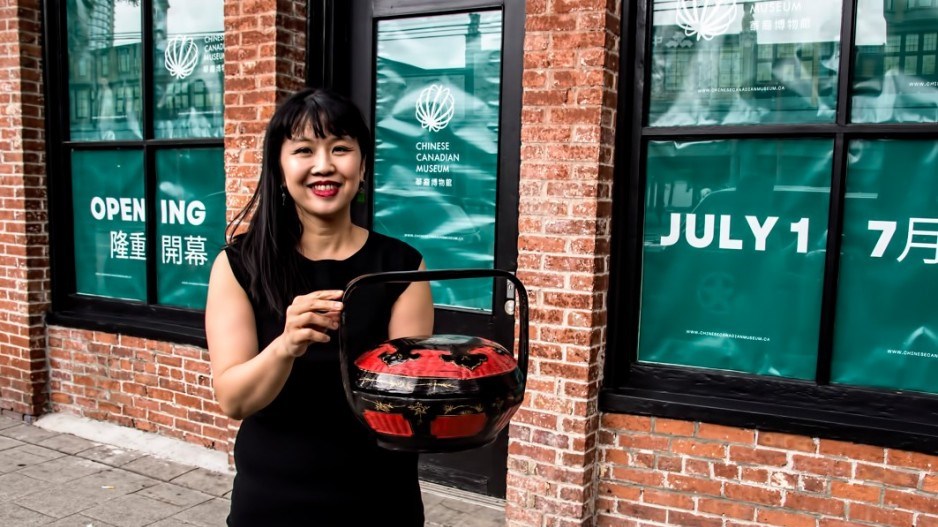Vancouver's Chinese Canadian Museum (CCM) is readying to launch operations July 1 in a site at 51 East Pender Street that formerly housed real estate marketer Bob Rennie's Rennie Marketing headquarters, and his Rennie Museum at Wing Sang.
The museum is set to open Wednesdays through Sundays, operate 10 a.m. through 5 p.m. and charge adults $15, seniors $12 and students $10. Those who pay to attend on weekends can take part in free guided tours in English, Cantonese and Mandarin.
CCM CEO Melissa Karmen Lee told BIV this afternoon that she has no set overall budget for the museum's first year.
"The business model for museums is usually to operate with one-third from government, one-third from private donations and one-third from our revenues," she said. "Revenues are everything from admissions to [venue] rental and events, to education and programs and school tours, when you charge."
The CCM bought the 21,000 site, which included offices and Rennie's art museum in February 2022 for about $30 million.
It funded that purchase with part of the $38.5 million that the provincial government had given to it up to that point. B.C. in April pledged a further $10 million to the CCM.
The CCM plans to keep about $8 million of the provincial money in an endowment fund that would generate proceeds to help fund future exhibits, Lee said. She plans to spend the recent $10 million pledge from the province on operations.
Ottawa's Department of Canadian Heritage and its Pacific Economic Development Agency of Canada (PacifiCan) last month teamed up to provide $5.179 million to the CCM, and Lee said she will use that money to finance operations as well as renovations.
The main exhibition at launch is set to be called “The Paper Trail to the 1923 Chinese Exclusion Act,” given that July 1 marks the 100th anniversary of Canada passing its 1923 Chinese Immigration Act, also known as the Chinese Exclusion Act, which was in effect until1947.
That law aimed to limit Chinese immigration to Canada by restricting Chinese men living in Canada from bringing over wives and children from China. It also required all people of Chinese descent to register with the federal government within 12 months of the law's passing.
Chinese Vancouverites were also subject to curfews after sundown - something that prompted those people to use secret narrow corridors between the backs of buildings as they could not openly travel on main roads.
When Rennie built his museum, he incorporated one of those corridors into his building's architecture to act as a powerful reminder of how Chinese people were forced to live, Rennie told BIV years ago.
Lee said that this corridor will also be part of the CCM. So will a 122-year-old schoolroom with an old blackboard that Rennie had been using as a meeting room in the office portion of the site.
"We're opening the schoolroom to the public for the first time," Lee said. "We've also built 1920s-period rooms to supplement the schoolroom space so people will be able to feel like they're transported back into the 1920s."
Lee's rationale for closing the museum on Mondays and Tuesdays is to give renovation workers time to do work that might be too noisy or disruptive were the museum to be open.
Before Lee joined the CCM in October, she was director of education and public programs at the Vancouver Art Gallery, which stays open until 8 p.m. on Thursdays and Fridays.
"That is something we're looking into," she said of staying open into some selected evenings. "Chinatown, the neighborhood, is very different from the downtown-Granville area so I think we're going to be looking at demand, and what kind of flows of people there are in the neighborhood."
Neglecting to open in evenings may have been one of the reasons the former Storyeum attraction failed in 2006 after a short-lived stint at 142 Water Street. That venue had actors performing historical scenes to try to bring alive Vancouver's history.
The CCM has hired eight full-time and 10 part-time employees and Lee said she is looking to hire a full-time curator.
Big expenses in the first year are expected to be salaries, property tax and construction.
Private donations to the CCM include $2.8 million from retired Senator Vivienne Poy and her family, through the Lee Tak Wai Foundation, $1 million from the David and Dorothy Lam Foundation and $1.1 million from Grace and Richard Wong.
In exchange, the CCM's introduction gallery is named the Poy Family Gallery. The rooftop garden - which formerly housed Martin Creed's art installation Everything Is Going to Be Alright - will be named the David and Dorothy Lam Garden. The schoolroom will be named in honour of Grace and Richard Wong.
Merchandise sales are expected to help the CCM increase revenue.
"We have what we're calling a gift kiosk," Lee said. "Until we have our full gift shop, what we're going to be doing is selling some goods from behind the counter."
Visitors can buy tote bags, children's toys and books. T-shirts are likely to be on sale at some point in the future, she added.



